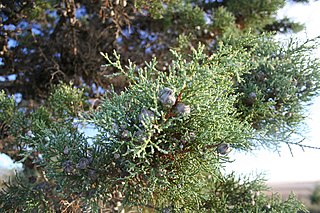
Cypress is a common name for various coniferous trees or shrubs of northern temperate regions that belong to the family Cupressaceae. The word cypress is derived from Old French cipres, which was imported from Latin cypressus, the latinisation of the Greek κυπάρισσος (kyparissos).
Cypress-pine is the common name used for three closely related genera of conifers in the cypress family Cupressaceae:

Actinostrobus is a genus of coniferous trees in the Cupressaceae. Common names include cypress, sandplain-cypress and cypress-pine, the last of these shared by the closely related genus Callitris.

Actinostrobus pyramidalis, commonly known as swamp cypress, Swan River cypress and King George's cypress pine, is a species of coniferous tree in the Cupressaceae. Like the other species in the genus Actinostrobus, it is endemic to southwestern Western Australia.

Eucalyptus melliodora, commonly known as yellow box, is a medium-sized to occasionally tall eucalypt. The bark is variable ranging from smooth with an irregular, short stocking, to covering most of the trunk, fibrous, dense or loosely held, grey, yellow or red-brown, occasionally very coarse, thick, dark brown to black; shedding from the upper limbs to leave a smooth, white or yellowish surface.

Actinostrobus arenarius is a species of conifer in the cypress family, Cupressaceae. Its common names include sandplain cypress, Bruce cypress, Bruce cypress-pine, and tamin. It is endemic to Western Australia.

Callitris baileyi is a species of conifer in the family Cupressaceae. It is found only in Australia, more specifically Southeast Queensland. Its common English name is Bailey's cypress-pine. The name is dedicated to Australian botanist Frederick Manson Bailey, who was the first to collect specimens of this tree. Bailey's name is closely associated with much of the flora of Queensland and their elucidation in Southeastern Queensland. Over the past few decades the conifer has been severely threatened by habitat loss Fruiting for the species has been recorded year-round.

Callitris drummondii, or Drummond's cypress, is a species of conifer in the Cupressaceae family. It is found only in Western Australia. It is threatened by habitat loss.

Callitris endlicheri, commonly known as the black cypress pine, is a species of conifer in the Cupressaceae family. It is found only in Australia.

Callitris macleayana is a species of conifer in the family Cupressaceae, endemic to Australia. The tree is commonly known as stringybark pine, as well as brush cypress pine and Port Macquarie pine, although it does not belong to the pine genus or family. Stringybark pine is found in two regions of Australia's East coast, one in the centre and one in the North.
Callitris monticola, or dwarf cypress, is a species of conifer in the Cupressaceae family. It shares the common name with several other plants.
It is found only in Australia.
It is threatened by habitat loss.

Callitris oblonga, also called South Esk pine, pigmy cypress pine, river pine, or Tasmanian cypress pine, is a species of conifer in the Cupressaceae family. It is endemic to Australia, and is threatened by habitat loss.

Callitris preissii is a species of conifer in the Cupressaceae family, endemic to Rottnest Island, Australia. Common names include Rottnest Island pine, Murray pine, maroong, southern cypress pine, or slender cypress pine. The Noongar peoples know the tree as marro.

Callitris rhomboidea, or Oyster Bay pine, is a species of conifer in the family Cupressaceae.
Callitris roei, or Roe's cypress-pine, is a species of Callitris native to Australia, where it is endemic to southwestern Western Australia from Moora south to Albany and east to Cape Arid National Park.
Callitris sulcata is a species of conifer in the cypress family, Cupressaceae. Its common name is Sapin de Comboui. It is endemic to New Caledonia, where it grows only in three forested river valleys. It is an endangered species with a global population of no more than 2500 individuals.
Theryaxia is a monotypic genus of beetles in the family Buprestidae, the jewel beetles. The single species is Theryaxia suttoni. It is endemic to Australia, where it occurs in New South Wales and Queensland.
Aenigmatineidae is a family of basal Lepidoptera, moths discovered on Kangaroo Island in South Australia. The family is based on a single species discovered in 2015, Aenigmatinea glatzella, commonly known as the "enigma moth". The larvae feed on conifers by mining the stem of Callitris plants in the cypress family. The adult has highly reduced mouthparts but its position in the Glossata containing the more familiar moths-with-tongues is confirmed by morphological and DNA sequence similarity. The group is best treated as a sister of the family Neopseustidae.












